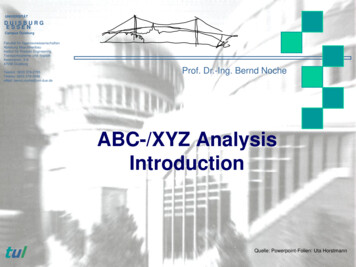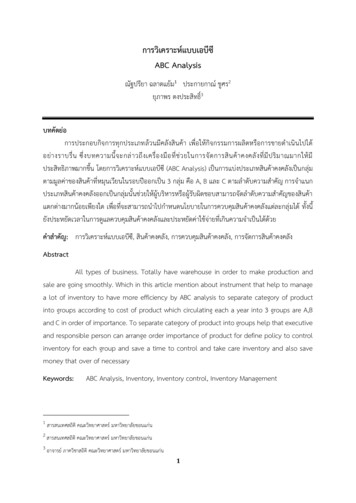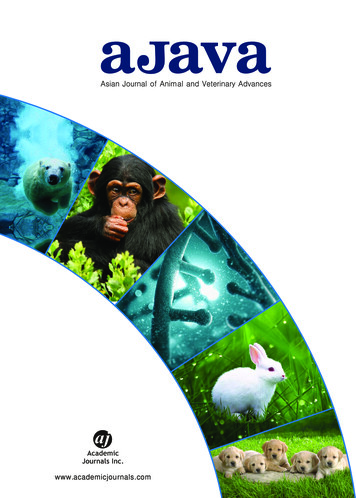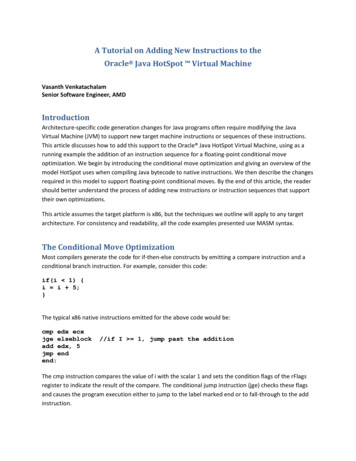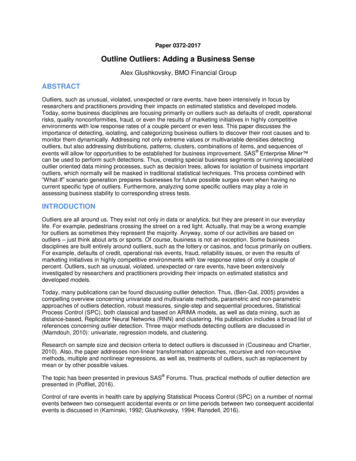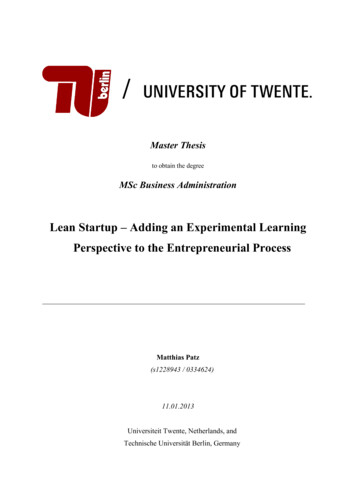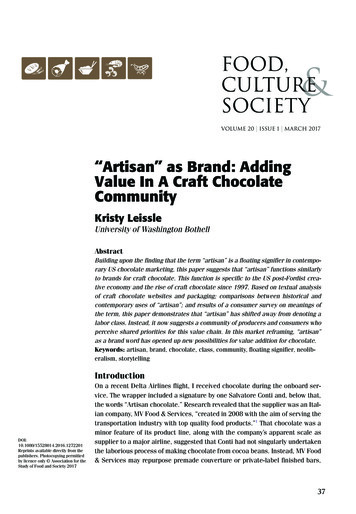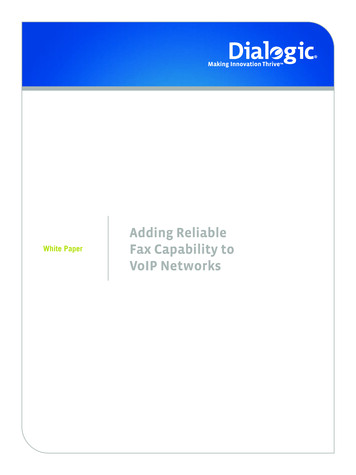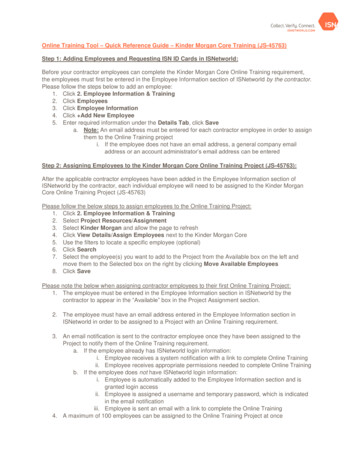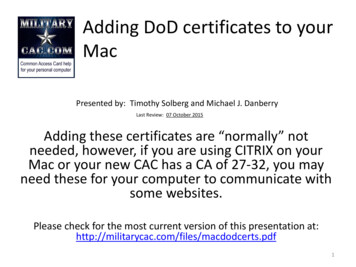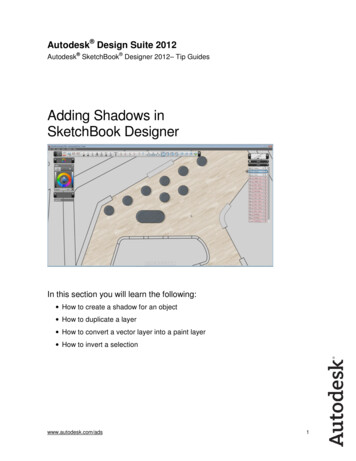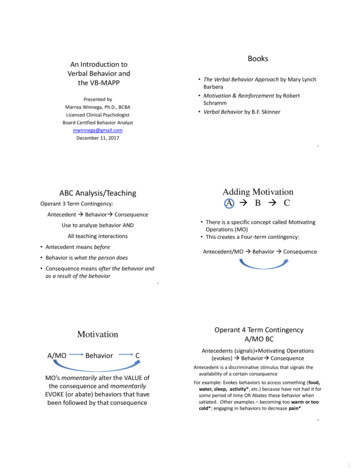
Transcription
BooksAn Introduction toVerbal Behavior andthe VB-MAPP The Verbal Behavior Approach by Mary LynchBarbera Motivation & Reinforcement by RobertSchramm Verbal Behavior by B.F. SkinnerPresented byMarrea Winnega, Ph.D., BCBALicensed Clinical PsychologistBoard Certified Behavior Analystmwinnega@gmail.comDecember 11, 20172Adding MotivationA B CABC Analysis/TeachingOperant 3 Term Contingency:Antecedent Behavior Consequence There is a specific concept called MotivatingOperations (MO) This creates a Four-term contingency:Use to analyze behavior ANDAll teaching interactions Antecedent means beforeAntecedent/MO Behavior Consequence Behavior is what the person does Consequence means after the behavior andas a result of the behavior3Operant 4 Term ContingencyA/MO BCMotivationA/MOBehaviorCMO’s momentarily alter the VALUE ofthe consequence and momentarilyEVOKE (or abate) behaviors that havebeen followed by that consequenceAntecedents (signals) Motivating Operations(evokes) Behavior ConsequenceAntecedent is a discriminative stimulus that signals theavailability of a certain consequenceFor example: Evokes behaviors to access something (food,water, sleep, activity*, etc.) because have not had it forsome period of time OR Abates these behavior whensatiated. Other examples – becoming too warm or toocold*; engaging in behaviors to decrease pain**These are unconditional motivating operations61
MotivationReinforcing Consequences Reinforcers SHIFT! And that is ok. Motivation for specific items can bealtered by: What we want or like at one moment willchange, especially when we are satisfied withit or satiated Creating a specific state (making thirsty) Limiting access to the specific item Signaling the availability of the item Adult example: Hard day at work. Don’t wantto cook. Go to favorite restaurant (SD; drivingthere and ordering are behaviors to get food).Then I’m full and done eating – satiated. I gohome and watch a movie or my favoritetelevision show, read a book, or call a friend. Ido not eat dessert because I am full/satiated. We must understand what motivates ourlearners Items our learners ask for or frequentlyplay with Items can be pleasing, but not function asreinforcers8Verbal OperantsAnalysis of Verbal BehaviorReinforcing Consequences Student example 1: Student really likes chips.When he does well, he gets 3 or 4 chips at atime. He gets chips for every 3 to 5 responses. Basically, this approach takes into account theantecedents (As) and consequences (Cs) thatsurround different types verbal behavior Example:Motivation: Students “wants” juiceTeacher/parent (antecedent): Holds the juiceand may say, “What do you want?” (and juice isavailable)“Juice” request (or mand) Juice (response)Reinforcer getting juice (consequence) When he has eaten a bag of chips, he will befull and no longer want the chips. And now he will need a drink (being thirsty).Reinforcer shifts to preferred beverage (couldbe water, milk, juice or pop – whateverstudent likes) because of motivatingoperation.9Verbal Behavior Teacher: “What is it?” (antecedent) Learner: “Juice”“Juice” labeled juice (response) Reinforcer/consequence socially mediated,non-specific reinforcement, the child does notget the juice in this situation (this is a label or“tact”).Topography/form of verbal behavior is the same“juice,” reinforcer is different1110Verbal BehaviorDifferent functions of verbal behavior do notautomatically generalize/transfer:***THIS IS THE KEY ***Essential functions:to request,label,answer questions,receive or give information.This means: When children with autism learn a label,it does not transfer to requests122
Verbal Behavior - Skinner Any oral and non-oral forms ofcommunication Mostly maintained by social reinforcement Forms include: Speaking, signing, pointing,writing, gesturing, touching, Braille, texting,emailing, beeping your horn at someone toget out of your way, etc. Excludes: Typing on a typewriterVerbal OperantsA:AntecedentWant juiceB:Response“Juice”C:ConsequenceReceive JuiceSee/feel juice“Juice”Praise/light up toy* Label/TactHear “juice”“Juice”PraiseVocal Imitation/Echoic“We stions aboutthings out ofsight/Intraverbal*optional/makespraise a reinforcerWhy not juice?Verbal OperantRequest/Mand1314Verbal OperantsA:AntecedentB:ResponseC:ConsequenceVerbal OperantsA:AntecedentVerbal OperantB:ResponseC:ConsequenceVerbal OperantWant ball“ball”Receive ballRequest/MandWant car“car”Receive carSee/feel ball“ball”Praise/pretzel*Label/TactSee/feel car“car”Praise/juice or Label/Tactlight up toy*Hear “ball”“ball”PraiseVocal Imitation/EchoicHear “car”“car”PraiseEchoic (Duplic)“We ride in a”OR “Name avehicle” OR“Something withwheels is res“We play with a”“ball”PraiseIntraverbal*optionalWhy not the ball?*optionalRequest/Mand1516Overlapping TermsVerbal Behavior - AdditionalClassifications of LanguageNote: Focus on function not structure/form Receptive Language: Following instructions or therequests/mands of others (When told, “Touch dog,”Learner touches the picture of dog) Imitation/Mimetic – copying sign language Copying Text Textual – reading written words Writing – write words you hear CommentBCBAMotivating OperationsCommunicative ExchangesGeneralizationCarry-over183
The VB-MAPPAn Introduction to the VerbalBehavior Milestones Assessmentand Placement Program: The VBMAPP Information fromMark SundbergAn assessment toolCurriculum guideTracking systemBased on the behavioral analysis of languageas described by B. F. Skinner in his bookVerbal Behavior (1957)20The VB-MAPP The VB-MAPPProvides criterion referenced informationregarding a child’s current skillsCan serve as a basis for the selection ofeducational objectivesProvides a skills tracking system: – to observe and document a student’s progress in theacquisition of critical skills and– to identify skill areas that remain in need of furtherdevelopment. Has been designed to assess a variety oflanguage skillsAccounts for a student’s motivationAccounts for the student to attend to both verbaland nonverbal stimuliEmphasizes generalization of skillsProvides an extensive list of skills*21The VB-MAPP 225 Components of the VB-MAPPBased on typical language developmentmilestonesIdentifies milestones for a sharper focus andclearer directionField test data from approximately 75 typicallydeveloping childrenField test data from over 200 children withautism23 VB-MAPP: Milestones Assessment– 170 verbal behavior milestones across 3developmental levels (0-18 months, 18-30months, 30-48 months) and 16 different verbaloperants and related skills VB-MAPP: Barriers Assessment– 24 common learning and language barriersfaced by children with autism VB-MAPP: Transition Assessment– Evaluates a child’s ability to learn in lessrestrictive educational environment across 18different skills244
5 Components of theVB-MAPPThe Milestones Assessment Identifies the child’s existing language andrelated skills. Contains 170 measurable learning andlanguage milestones that are sequencedand BALANCED across 3 developmentallevels. IEP goals can match the milestones insteadof individual skills VB-MAPP: Skills Task Analysis and Tracking– Breakdown of the different skill areas– Checklist for skills tracking VB-MAPP: Placement and IEP Goals– Recommendations for program developmentbased on the student’s VB-MAPP profile– Over 200 IEP objectives directly linked to theskills and barriers assessments25Rationale2616 Milestones Assessment Typical verbal milestones help to– avoid focusing on only minor steps– avoid targeting skills for intervention thatare developmentally inappropriate The elementary verbal operants (e.g.,echoic, mand, tact, intraverbal) The listener skills Vocal output Independent play Social skills and social play By identifying milestones, as opposed to atask analysis of individual skills, the focuscan be sharper and the direction clearer.2728Milestones Assessment16 Milestones Assessment The milestones are broken into 3developmental levels: Visual perceptual skills and matching-tosample Grammatical and syntactical skills Group and classroom skills Beginning academic skills– Level 1: 0 – 18 months (most children withautism are here)– Level 2: 18 – 30 months (significantdevelopmental changes in typical childrenoccur during this time)– Level 3: 30 – 48 months (Intraverbals andconversation develop)29305
The VB-MAPPBarriers AssessmentAdditional InformationAbout the Levels The goal is for the student to not only makeprogress upward – but also across areas. Level 1 should be filled in before reallyfocusing on Level 2 – Achieve a BALANCE This ensures that foundation repertoiresare developed prior to moving into higherlevel more complex areas. It is important to find out what a child can do(the VB-MAPP Milestones Assessment), butalso important to know what they cannot doand analyze why they cannot do it. It is designed to identify and score 24 learningand language acquisition barriers that mightimpede a student’s progress.3132General Categories of BarriersRationale Absence of skills and the presence of barriersare closely related. Intervention program should include both skillsthat need to be increased and behavior orbarriers that need to be decreased. For some students the immediate programshould focus on removing a particular barrier.1. Negative Behavior and Cooperation2. Absent, Weak or Defective Verbal Operants3. Social Behavior4. Fundamental Barriers to Learning5. Specific Behaviors that Compete with Learning6. Physical Barriers3334Why look at the Barriers? For some children the immediate focus ofthe intervention program is on removing aparticular barrier, rather than languageinstruction The most common immediate barriers toremove involve instructional controlproblems, or other behavior problems Focus: Increase manding, cooperation andwaiting; decrease problem behavior356
The VB-MAPP Barriers Assessment It is important to find out what a child can do (the VB-MAPP Milestones Assessment), but also important to know what they cannot do and analyze why they cannot do it. It is designed to identify and score 24 learning and language acquisition barriers that might impede a student’s progress. 32 Rationale Absence of skills and the presence of barriers are .
